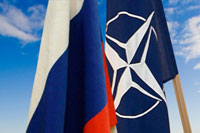Does NATO Really Think Russia is That Silly?
NATO Secretary General Anders Fogh Rasmussen believes Russia should resume negotiations about the Conventional Armed Forces in Europe Treaty.

The official also said that he was going to discuss the initiative regarding the nuclear disarmament with foreign ministers of 28 members of the alliance. He said that the volume of nuclear arms in the world was supposed to be reduced to the reasonable level which would be adequate to present-day threats.
Where does Rasmussen want Russia to be?
The above-mentioned treaty was signed on November 19, 1990 in Paris. There was another organization that existed during those times – the Warsaw Treaty Organization, or Warsaw Pact. The document restricted the number of arms, which the feuding blocs could have on the borderline between them.
The total number of arms for the two military blocs was not supposed to exceed the following quantities: 40,000 tanks, 60,000 armored vehicles, 40,000 heavy artillery units, 13,600 combat fighter jets and 4,000 combat helicopters. The numbers were altered during the 1990s.
The document was changed in 1992 following the break up of the USSR and the Warsaw Pact. Former Soviet states signed a separate treaty the same year in Uzbekistan. Russia’s quota made up 6,400 tanks, 11,480 armored vehicles, 6,415 artillery systems, 3,450 planes and 890 helicopters. In addition, Russia moved a big part of its heavy arms behind Ural Mountains.
Russia ratified the treaty in 1992, but her example did not inspire several other members of the former USSR. Azerbaijan and Georgia signed the document, but did not ratify it. Lithuania, Latvia and Estonia refused to put their signatures on the document.
The situation in Europe had changed drastically by the end of the 1990s. USSR’s former Warsaw Pact partners – Poland, the Czech Republic and Hungary - joined NATO in spite of the fact that NATO promised not to expand in the east. The change required an addition be made to the Conventional Armed Forces in Europe Treaty, which was done at the OSCE summit in Turkey on November 19, 1999.
The quotas of Russia and other countries of the former USSR remained on the level of the agreement signed in Uzbekistan. The quota for all NATO members was the following: 19,096 tanks, 31,787 armored vehicles, 19,529 artillery systems, 7,273 planes and 2,282 helicopters. The quota was subsequently increased later, after Bulgaria, Romania, the Baltic States and Slovenia became NATO members.
The ratification of the document was quite a problematic matter. Only Russia, Ukraine, Belarus and Kazakhstan ratified it. Georgia and Moldavia refused demanding the removal of Russian troops from their territories. Russia later decided to withdraw its army bases from those two countries, but said that the decision had nothing to do with the Conventional Armed Forces in Europe Treaty.
All Russian bases were liquidated in Georgia in ten years. Russia only left a small group of its troops in Transdniestria. The treaty did not come in effect: NATO members refused to ratify it claiming that Russia had not implemented its obligations.
The situation in Europe was worsening. Lithuania, Latvia and Estonia joined NATO in 2004. The new members refused to sign the treaty. It means that these countries have no arms restricting obligations, and their territories can turn into a large warehouse of arms located only 500 kilometers far from Moscow and 200 kilometers far from St. Petersburg.
The situation became more serious in 2007, when the US administration planned to deploy missile defense system elements in Poland and the Czech Republic. NATO planes began to patrol the sky of the Baltic States, and the defense machine found itself very close to Russian borders.
Such an outcome was a total contradiction to all obligations of NATA members. As a result, Russia pulled out from the Conventional Armed Forces in Europe Treaty at the end of 2007 since the most of its members did not meet the terms of the treaty.
A year later, Russia put forward a way out of the dead end – a new European security treaty. However, NATO secretary general repeatedly stated that he did not see any need in such an agreement. However, Mr. Rasmussen wants Russia to execute the agreement, which was never put in effect because of NATO members’ unwillingness to ratify it. He never said a word about it, of course.
Vadim Trukhachev
Pravda.Ru
Russia Today: Cancer: NATO's time bomb in the Balkans
Subscribe to Pravda.Ru Telegram channel, Facebook, RSS!





